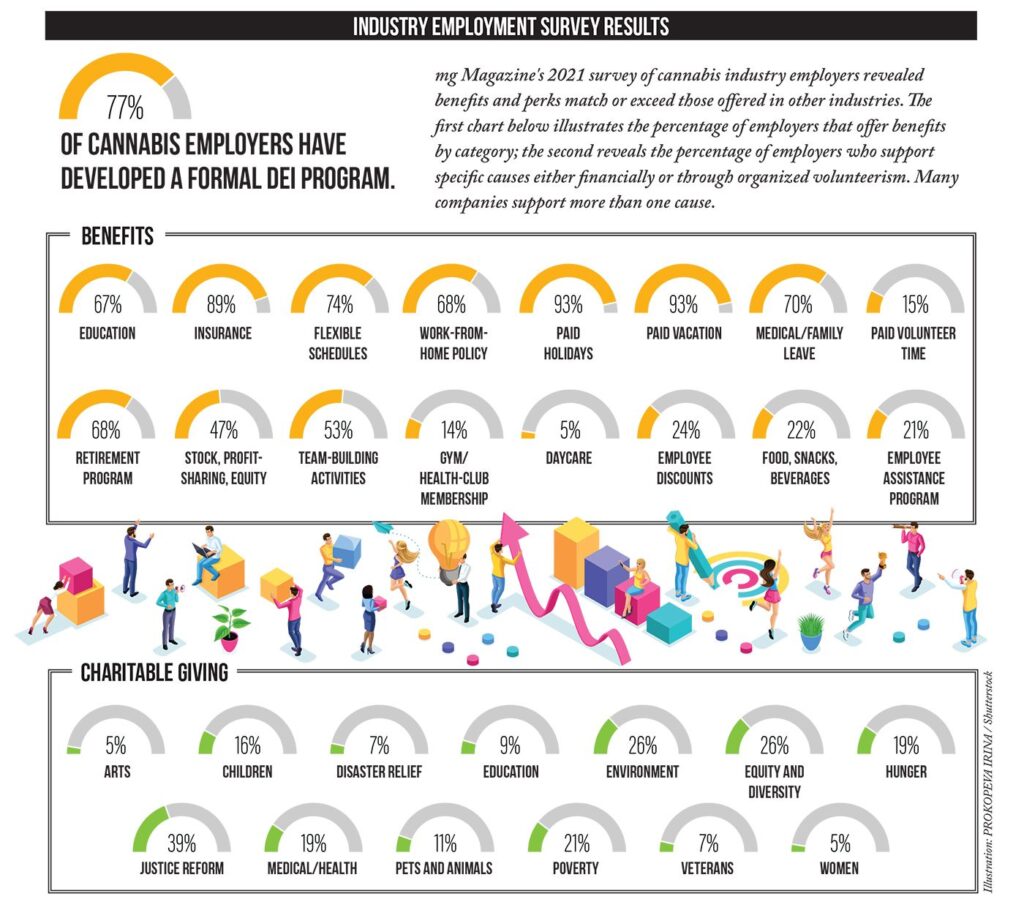Legal cannabis sales in the United States surpassed $17.5 billion in 2020, growing 45 percent over 2019’s total. Market research firm BDSA expects revenues to grow another 38 percent in 2021, topping $24 billion. Currently, the U.S. market represents about 80 percent of revenues worldwide.
Clearly, the industry is doing well—so well, in fact, that employers added almost 80,000 jobs in 2020, according to Leafly’s 2021 Jobs Report. The new positions brought the total number of people employed across all industry sectors to more than 321,000, a growth of 32 percent year over year and 61 percent over 2017’s total. At the end of 2020, more people worked in cannabis jobs than as dentists, emergency medical technicians, aircraft pilots, or electrical engineers.

Although some companies reduced staffing levels early in the pandemic, most returned to pre-pandemic levels once cannabis was declared an “essential business.” Many added additional team members to deal with increased demand for products and services (especially delivery), making the cannabis industry one of the few that didn’t contribute to the 14.8-percent unemployment rate observed in July 2020—the highest ever recorded. The industry also is not suffering from “the Great Resignation,” a phenomenon that developed in mid-2021 as employees, presumably having reevaluated their career choices during the COVID-19 pandemic, abandoned their jobs in droves. In October, the U.S. Department of Labor estimated about 4 million people were resigning monthly.
Some industries, particularly hospitality and retail, continue to struggle to find enough workers to fill core positions. Employers complain candidates simply fail to show up for work after they are hired or walk off their jobs mid-shift.
Cannabis jobs offer better pay
The primary reasons workers cite for abandoning jobs: low pay, few benefits, and a lack of schedule flexibility. Cannabis employers are fulfilling those requirements. “There has been a seismic shift of workers from retail and restaurants to cannabis,” said Kara Bradford, chief executive officer for cannabis recruiting firm Viridian Staffing.

Pay is a primary incentive for entering the industry, especially in fields where risk of exposure to COVID-19 is high. The federal minimum wage is a mere $7.25 per hour (required of companies with annual gross sales of at least $500,000), and most states mandate at least that much. The outliers on the low end are Georgia and Wyoming, which require small businesses to pay only $5.15 an hour; that rate hasn’t changed since 2002 and comes nowhere near meeting the rapidly rising cost of living. On the other end of the scale, Washington D.C. mandates a minimum of $15.20. California’s minimum wage rose to $15 an hour on January 1, 2022. A handful of other states will raise their minimums to $15 between January 1, 2023, and September 30, 2026: Connecticut, Delaware, Florida, Illinois, Maryland, Massachusetts, New Jersey, Rhode Island, and Virginia. Another thirteen states tie wage increases to the consumer price index; minimums there are projected to reach $15 sometime after 2026.
In contrast, cannabis businesses across all categories typically pay $12 to $15 an hour for entry-level jobs; executive salaries can reach well into the six-figure range. Better still, compensation is on the rise: Pay for cultivation workers, for example, increased by 5 percent to 11 percent during 2021.
Cannabis jobs offer more flexibility

According to a study by The Harris Poll, 76 percent of employed Americans considered changing jobs during 2021 in order to obtain more flexibility, even at the expense of lower pay. Cannabis employers address that desire. mg Magazine’s 2021 “America’s Top Cannabis Employers” survey discovered 80 percent of companies in the industry, regardless of size, offer flexible schedules, a work-from-home option, or both. A dozen companies either pay a home-office stipend or provide remote employees with all the equipment and furnishings they need to perform their jobs.
Additional paid time off is another popular benefit. Fifteen percent of companies pay employees for days spent doing volunteer work, and a handful reduce summer work weeks to four days while continuing to compensate workers for five. One employer observes a paid five-day “unplugged” weekend every quarter, during which the company closes and employees are encouraged not to check email or respond to work-related issues. Another company closes from December 24 through January 1 every year and does not deduct the period from the paid vacation time employees have earned.
Cannabis jobs’ benefits are better
The depth and breadth of benefits packages also attract workers to the industry. mg’s survey revealed the vast majority of companies (93 percent) offer paid holidays, sick time, and vacations, and 70 percent offer family/medical leave (including parental leave). More than two-thirds offer retirement plans of some kind. Nearly nine in ten offer health insurance; some provide additional options, including dental, vision, disability, and life insurance for employees and their families. A few toss in pet insurance. Some of those benefits may be due to a recent trend toward unionization. Although only a handful of workforces have voted to join the United Food and Commercial Workers, the trend may be impacting how non-union shops design their packages in order to remain competitive.

Employee assistance programs showed up for the first time in the 2021 survey, many possibly developed in response to the pandemic. Offered by 21 percent of employers, the programs provide financial assistance for disaster relief and personal tragedy, legal expenses, financial and mental health counseling, and other emergency needs or economic challenges. During the height of the pandemic, hourly employees at one ancillary company were offered four weeks of “COVID leave.” Any of that time unused by December 31, 2020, was paid as a lump-sum bonus.
Less common benefits include wholesale club memberships, group discounts on things like tires and household goods, on-the-job food and beverages, longevity bonuses (one company offers $10,000 after ten years), tuition reimbursement, and employee grants for personal development.
Cannabis jobs are more fulfilling
Cannabis businesses also attempt to address employees’ sense of fulfillment and community involvement, which were among the lesser-mentioned reasons for job dissatisfaction in the Harris poll. Every company that responded to mg’s 2021 survey has adopted at least one cause; many support five or more. Most corporate donations and volunteer efforts are employee-led. And more than three-quarters of employers are heavily invested in diversity, equity, and inclusion (DEI), with efforts ranging from the creation of employee resource groups and advisory panels to financial support for nonprofits, reevaluating vendor relationships, community service, talent-development programs, training and employment opportunities for formerly incarcerated persons, and entrepreneurship grants for individual employees.
As the national economy recovers from the worst downturn in eighty years and inflation soars to a forty-year high, American cannabis companies are demonstrating workers don’t have to suffer in jobs that don’t meet their financial, emotional, or work/life balance goals. More power to them.













